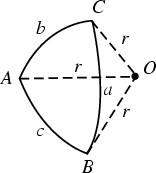|
|
|

|
A spherical triangle is a figure formed on the surface of a sphere by three great circular arcs intersecting pairwise in three
vertices. The spherical triangle is the spherical analog of the planar Triangle. Let a spherical triangle have
Angles ![]() ,
, ![]() , and
, and ![]() and Radius
and Radius ![]() . Then the Area of the spherical triangle is
. Then the Area of the spherical triangle is
The study of angles and distances of figures on a sphere is known as Spherical Trigonometry.
See also Colunar Triangle, Girard's Spherical Excess Formula, L'Huilier's Theorem, Spherical Polygon, Spherical Trigonometry
References
Abramowitz, M. and Stegun, C. A. (Eds.).
Handbook of Mathematical Functions with Formulas, Graphs, and Mathematical Tables, 9th printing.
New York: Dover, p. 79, 1972.
Beyer, W. H. CRC Standard Mathematical Tables, 28th ed. Boca Raton, FL: CRC Press, pp. 131 and 147-150, 1987.